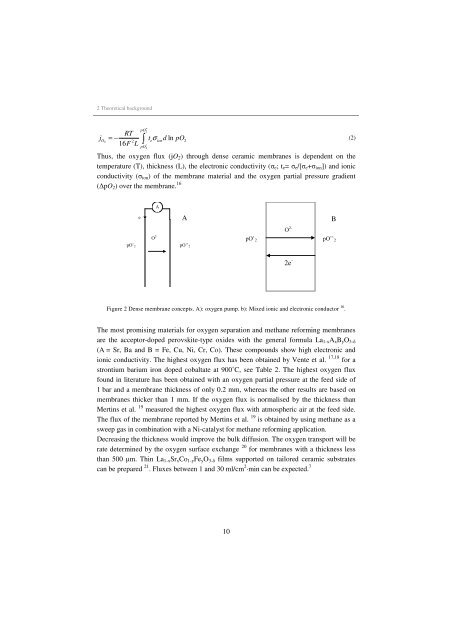Inorganic Microporous Membranes for Gas Separation in Fossil Fuel ...
Inorganic Microporous Membranes for Gas Separation in Fossil Fuel ...
Inorganic Microporous Membranes for Gas Separation in Fossil Fuel ...
Create successful ePaper yourself
Turn your PDF publications into a flip-book with our unique Google optimized e-Paper software.
2 Theoretical background<br />
pO2′′<br />
RT<br />
j = − ∫ t σ d ln pO<br />
(2)<br />
O2 2 e ion<br />
16F<br />
L pO2′<br />
2<br />
Thus, the oxygen flux (jO2) through dense ceramic membranes is dependent on the<br />
temperature (T), thickness (L), the electronic conductivity (σe; te= σe/[σe+σion]) and ionic<br />
conductivity (σion) of the membrane material and the oxygen partial pressure gradient<br />
(∆pO2) over the membrane. 16<br />
pO’2<br />
e<br />
A<br />
O 2-<br />
A B<br />
pO’’2<br />
10<br />
pO’2<br />
O 2-<br />
pO’’2<br />
Figure 2 Dense membrane concepts. A): oxygen pump. b): Mixed ionic and electronic conductor 16 .<br />
The most promis<strong>in</strong>g materials <strong>for</strong> oxygen separation and methane re<strong>for</strong>m<strong>in</strong>g membranes<br />
are the acceptor-doped perovskite-type oxides with the general <strong>for</strong>mula La1-xAxByO3-δ<br />
(A = Sr, Ba and B = Fe, Cu, Ni, Cr, Co). These compounds show high electronic and<br />
ionic conductivity. The highest oxygen flux has been obta<strong>in</strong>ed by Vente et al. 17,18 <strong>for</strong> a<br />
strontium barium iron doped cobaltate at 900˚C, see Table 2. The highest oxygen flux<br />
found <strong>in</strong> literature has been obta<strong>in</strong>ed with an oxygen partial pressure at the feed side of<br />
1 bar and a membrane thickness of only 0.2 mm, whereas the other results are based on<br />
membranes thicker than 1 mm. If the oxygen flux is normalised by the thickness than<br />
Mert<strong>in</strong>s et al. 19 measured the highest oxygen flux with atmospheric air at the feed side.<br />
The flux of the membrane reported by Mert<strong>in</strong>s et al. 19 is obta<strong>in</strong>ed by us<strong>in</strong>g methane as a<br />
sweep gas <strong>in</strong> comb<strong>in</strong>ation with a Ni-catalyst <strong>for</strong> methane re<strong>for</strong>m<strong>in</strong>g application.<br />
Decreas<strong>in</strong>g the thickness would improve the bulk diffusion. The oxygen transport will be<br />
rate determ<strong>in</strong>ed by the oxygen surface exchange 20 <strong>for</strong> membranes with a thickness less<br />
than 500 µm. Th<strong>in</strong> La1-xSrxCo1-yFeyO3-δ films supported on tailored ceramic substrates<br />
can be prepared 21 . Fluxes between 1 and 30 ml/cm 2 ·m<strong>in</strong> can be expected. 7<br />
2e -

















